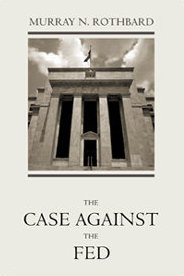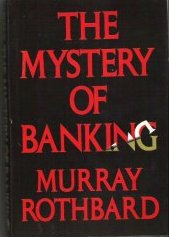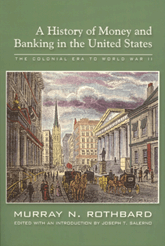
Anarcho-capitalism is an anti-statist, libertarian, political philosophy and economic theory that seeks to abolish centralized states in favor of stateless societies with systems of private property enforced by private agencies, the non-aggression principle, free markets and the right-libertarian interpretation of self-ownership, which extends the concept to include control of private property as part of the self. In the absence of statute, anarcho-capitalists hold that society tends to contractually self-regulate and civilize through participation in the free market, which they describe as a voluntary society involving the voluntary exchange of services and goods. In a theoretical anarcho-capitalist society, the system of private property would still exist and be enforced by private defense agencies and/or insurance companies selected by customers, which would operate competitively in a market and fulfill the roles of courts and the police.

Murray Newton Rothbard was an American economist of the Austrian School, economic historian, political theorist, and activist. Rothbard was a central figure in the 20th-century American libertarian movement and a founder and leading theoretician of anarcho-capitalism. He wrote over twenty books on political theory, history, economics, and other subjects.
The Specie Payment Resumption Act of January 14, 1875 was a law in the United States that restored the nation to the gold standard through the redemption of previously-unbacked United States Notes and reversed inflationary government policies promoted directly after the American Civil War. The decision further contracted the nation's money supply and was seen by critics as an exacerbating factor of the so-called Long Depression, which struck in 1873.

In the United States, banking began by the 1780s along with the country's founding and has developed into highly influential and complex system of banking and financial services. Anchored by New York City and Wall Street, it is centered on various financial services namely private banking, asset management, and deposit security.
The Panic of 1819 was the first widespread and durable financial crisis in the United States that slowed westward expansion in the Cotton Belt and was followed by a general collapse of the American economy that persisted through 1821. The Panic heralded the transition of the nation from its colonial commercial status with Europe toward an independent economy.

Monetary reform is any movement or theory that proposes a system of supplying money and financing the economy that is different from the current system.
Full-reserve banking is a system of banking where banks do not lend demand deposits and instead, only lend from time deposits. It differs from fractional-reserve banking, in which banks may lend funds on deposit, while fully reserved banks would be required to keep the full amount of each customer's demand deposits in cash, available for immediate withdrawal.
The Long Depression was a worldwide price and economic recession, beginning in 1873 and running either through March 1879, or 1896, depending on the metrics used. It was most severe in Europe and the United States, which had been experiencing strong economic growth fueled by the Second Industrial Revolution in the decade following the American Civil War. The episode was labeled the "Great Depression" at the time, and it held that designation until the Great Depression of the 1930s. Though a period of general deflation and a general contraction, it did not have the severe economic retrogression of the Great Depression.
This history of central banking in the United States encompasses various bank regulations, from early wildcat banking practices through the present Federal Reserve System.

The Federal Reserve System has faced various criticisms since it was authorized in 1913. Nobel laureate economist Milton Friedman and his fellow monetarist Anna Schwartz criticized the Fed's response to the Wall Street Crash of 1929 arguing that it greatly exacerbated the Great Depression. More recent prominent critics include former Congressman Ron Paul.

Paul Moritz Warburg was a German-born American investment banker who served as the second vice chairman of the Federal Reserve from 1916 to 1918. Prior to his term as vice chairman, Warburg served as one of the original members of the Federal Reserve Board of Governors, taking office in 1914. He was an early advocate for the establishment of the US central bank system.

The National Democratic Party, also known as Gold Democrats, was a short-lived political party of Bourbon Democrats who opposed the regular party nominee William Jennings Bryan in the 1896 presidential election. The party was then a "liberal" party in the context of the times, which is more of a fiscal-conservative or classical-liberal in the political context of the United States today.

Ludwig Heinrich Edler von Mises was an Austrian School economist, historian, logician, and sociologist. Mises wrote and lectured extensively on the societal contributions of classical liberalism. He is best known for his work on praxeology studies comparing communism and capitalism.

Joseph T. Salerno is an American Austrian School economist who is Professor Emeritus of Economics in the Finance and Graduate Economics departments at the Lubin School of Business at Pace University, Academic Vice President of the Ludwig von Mises Institute, and holds the John V. Denson II Endowed Professorship in the economics department at Auburn University. He earned his B.A. at Boston College and his M.A. and Ph.D. at Rutgers University.

Conceived in Liberty is a 5-volume narrative by Murray Rothbard on the history of the United States from the pre-colonial period through the American Revolution.

Martin Russell Thayer was a Republican member of the U.S. House of Representatives from the U.S. state of Pennsylvania.

Suffolk Bank was a private clearinghouse bank in Boston, Massachusetts, that exchanged specie or locally backed bank notes for notes from country banks to which city-dwellers could not easily travel to redeem notes. The bank was issued its corporate charter on February 10, 1818 by the 38th Massachusetts General Court to a group of the Boston Associates, and the charter's holders and bank's directors met periodically from February 27 to March 19 at the Boston Exchange Coffee House to discuss the organization of the bank. On April 1, 1818, the bank opened for business in rented offices on State Street until the bank moved permanently to the corner of State and Kilby Streets on April 17. In addition to Jackson and Parker, other prominent shareholders of the bank included William Appleton, Nathan Appleton, Timothy Bigelow, John Brooks, Gardiner Greene, Henry Hubbard, Augustine Heard, Amos Lawrence, Abbott Lawrence, Luther Lawrence, William Prescott, Dudley Leavitt Pickman, and Benjamin Seaver.

The Case Against the Fed is a 1994 book by Murray N. Rothbard criticising the United States Federal Reserve, fractional reserve banking, and central banks in general. It details a history of fractional reserve banking and the influence that bankers have had on monetary policy over the last few centuries.

The Mystery of Banking is Murray Rothbard's 1983 book explaining the modern fractional-reserve banking system and its origins. In his June 2008 preface to the 298-page second edition, Douglas E. French suggests the work also lays out the “...devastating effects [of fractional-reserve banking] on the lives of every man, woman, and child.”

Benjamin Strong Jr. was an American banker. He served as Governor of the Federal Reserve Bank of New York for 14 years until his death. He exerted great influence over the policy and actions of the entire Federal Reserve System and indeed over the financial policies of all of the United States and Europe.















